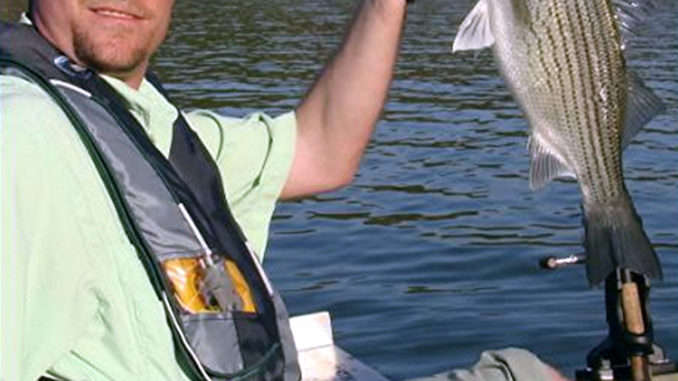
Summer stripers love tailraces: fast, cool water
July is a headache for most anglers. Although there’s some good fishing to be found — usually in the deeper, more wide-open areas — you’ll also be sharing your fishing locations with skiers, pleasure boaters and the like. It can also be hot as blazes, which means you either fish at night or in the first couple of hours of the morning and call it a day.
For kayaking anglers, summer is a great time. You’re in the water almost as much as you’re on the water, so the heat that plagues other boats is almost welcome. As for finding fish, this is the time when paddlers who haven’t already been fishing head for the river.
Stewart Venable, a part-time guide and pro staff member of Jackson Kayaks, is the kind of guy who rarely leaves the river. He looks forward to the summer, and especially late June and July, when he can float and fish the tailraces below dams that impound major reservoirs. Venable’s home water during the summer is the Catawba River below Lake Wylie, where hungry striped bass frequently seek shelter from the summer heat by holding in the cold water released from the bottom of the reservoir.
“From the tailrace (downstream) for a couple miles, the cold water that’s released from the dam will create cool-water habitat for striped bass,” said Venable (704- 307-9427). “Only two locations on an impoundment provide cool water for stripers during the summer. You’ll find them out in deep water on the main part of a lake or in the cool-water discharge area behind the dam. That wide-open part of the lake is where all the boat traffic will be. You won’t find any of those boats where I fish.”
Targeting moving-water striped bass from a kayak is a matter of being able to read water and determine what areas fish will find attractive for hiding while either just hanging out or stalking prey.
“The approach is going to vary depending on whether or not we’re fishing directly below the dam or hunting fish in the pockets,” he said. “Directly the below the dam, we can use a few different approaches. Live bait is always an option. If we’re using live bait, we’re going to be using medium heavy tackle and 4/0 circle hooks with live shad. I prefer a relatively small weight that will bounce along the bottom without hanging up. We want that bait to move with the current but to be slow enough to where the fish can get a good profile on it and attack the bait.”
One major disadvantage of live bait is providing a bait well or tank to keep the bait healthy. Several varieties of bait tanks used may range from a 5-gallon bucket to a troll bucket that is pulled along beside the boat. Using fresh cut bait is a little easier since a small cooler full of ice will keep the bait fresh for a day’s use.
Artificial baits are generally favored because they present more sport that just soaking live or cut bait and are easier to carry a variety of to match the conditions.
“We use a lot of standard bucktails with a Fluke-style bait on the back to give it a slightly larger profile, because we want the bigger fish to key in on it,” Venable said. “If we find the right current seams, we’re going to be casting at about 11 o’clock and letting the bait carry it out in front of us. Stripers will move up and will hold in those current seams where the current’s literally pushing the bait in their face. You need a bait that you can cast into heavy current and maneuver it to follow those current breaks and current seams to the fish.”
Most of Venable’s outings involve one-way floats; a party of anglers put in below the dam, float and paddle a few miles and take out without having to go upstream. Timing these floats with water releases from the upstream dam has its advantages for fishing but is a little more difficult to navigate.
“We honor the skill level of our clients. We usually do try to time it somewhat, coinciding with water releases, as long as they’re following the schedule, which, of course, the power companies don’t always do,” he said.
Fishing during a water release isn’t mandatory. Venable said the fish don’t leave the area. In fact, striped bass who commit to an upstream lifestyle aren’t likely to leave the area all summer.
“We can catch fish anytime,” he said. “The advantage of running water is the fish move up directly below the dam. If they’re not running water, we can hunt them down in the deeper pockets below the dam because the fish will back off the dam into deeper holes. We can find them there, even when they’re not generating water.”




Be the first to comment